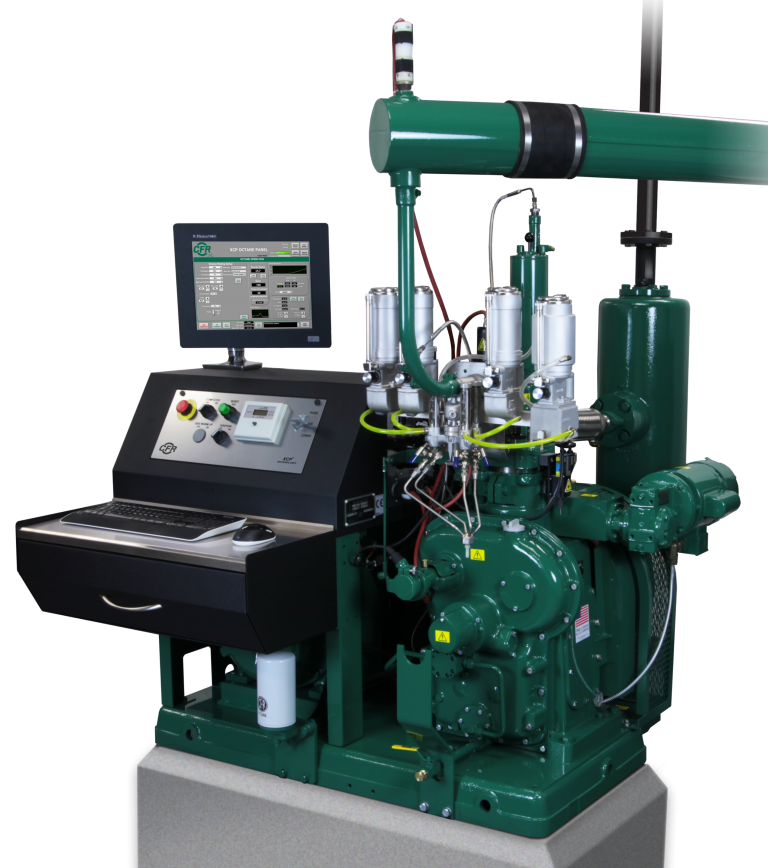When it comes to determining the anti-knock characteristics of motor fuels, the CFR F1/F2 Octane Rating Unit stands as the global standard. Since its inception in 1929, CFR has been instrumental in developing test methods for rating fuels. With a focus on collaboration with the automotive and petroleum industries, CFR continuously enhances its product line to facilitate the development of high-performing fuel products. In this article, we explore the advantages and features of the CFR F1/F2 Octane Rating Unit, which offers precision, reliability, and flexibility to fuel producers and engine manufacturers.
Confidence in a Fully integrated Fuel Testing System:
Engine Air Control System: Seamlessly controls critical parameters for successful octane testing.
F1/F2 Octane Rating Engine: Key equipment specified for testing fuels according to global standards.
XCP™ Technology: Provides data integrity and automated reporting.
CFR® Exhaust Surge Tank: Ensures smooth operation of the system.
Integrated Solution: Designed, manufactured, and tested by CFR to work seamlessly.
Data Integrity with XCP Technology:
XCP Digital Control Panel: Automatically captures critical information and generates ready-to-use Excel-based reports.
Minimized Errors: Reduces manual data recording and calculating errors.
Standard Report: Includes KI values, Octane Numbers, environmental data, and KI vs fuel level curves.
Integration with LIMS: Capable of being integrated into a Laboratory Information Management System for enhanced efficiency.
Reliability of Proven Design:
Proven Service: CFR Engines Inc. products have provided reliable service since 1929.
Robust Components: Engine crankcase and cylinder/head built for long-lasting performance.
Unsurpassed Operating Life: Built to withstand the demands of fuel testing with basic maintenance and upkeep.
Engine-based Octane Number: Delivers precision and accuracy for reliable results.
Precision through Modern Instrument Control:
Digital Instrumentation: Records and processes critical aspects of system operation and performance.
On-board Barometric Pressure Adjustments: Enables accurate measurements and adjustments.
Increased Automation: Reduces manual interventions and improves precision.
Intuitive Interface: User-friendly interface for better control and overall precision.
Cost Savings with One System Flexibility:
Versatility: Switch between any of the four test procedures in ASTM Methods D2699 or D2700 with ease.
Resource Utilization: Greater utilization of resources and reduced operator training.
Quicker Test Changes: Enables swift transitions between different tests.
Improved Repeatability: Enhances consistency and accuracy with a single system.
Other Important Features:
XCP Integrated Safety Monitoring System: Ensures shutdown protections for various scenarios.
User-Friendly Touch-Screen HMI Panel: Easy operation and control for octane rating tests.
Built-in Prompts: Improves consistency between operators by guiding them through test procedures.
Thermal Siphon Cooling Condenser: Maintains stable operation through constant cylinder jacket water temperature.
Digital Knock Meter: Displays actual knock intensity value for precise measurements.
Maintenance and Diagnostic Features: Provides easy troubleshooting and maintenance information.
On-Screen Manuals: Quick access to operations and maintenance guides.
Certainly! Here are 10 frequently asked questions (FAQs) about CFR F1/F2 Octane Rating Units:
What is a CFR F1/F2 Octane Rating Unit?
The CFR F1/F2 Octane Rating Unit is a globally accepted standard for determining and certifying the anti-knock characteristics of motor fuels, including gasoline, fuel constituents, and alternative fuels.
What are the main test methods used by CFR F1/F2 Octane Rating Units?
The CFR F1/F2 Octane Rating Engines are specified equipment for testing fuels according to ASTM D2699 (Research Octane Number) and ASTM D2700 (Motor Octane Number), as well as IP 236 and IP 237 test methods.
How does the CFR F1/F2 Octane Rating Unit ensure data integrity?
The unit incorporates XCP Technology, which automatically captures critical information and presents it in a ready-to-use Excel-based report. This minimizes manual data recording and calculating errors.
What is the reliability of CFR F1/F2 Octane Rating Units?
CFR Engines Inc. has a long history of providing reliable products since 1929. The units undergo continuous upgrades and enhancements to ensure long-lasting performance and withstand the demands of fuel testing.
What advantages does the CFR F1/F2 Octane Rating Unit offer in terms of precision?
The unit utilizes modern instrument control, including digital instrumentation and on-board barometric pressure adjustments. These features enhance accuracy, broaden the octane meter range, and provide better overall precision.
Can the CFR F1/F2 Octane Rating Unit handle different test procedures?
Yes, the unit offers one system flexibility, allowing users to switch between any of the four test procedures specified in ASTM Methods D2699 and D2700 with a few simple component changes and push button control.
What safety features are included in the CFR F1/F2 Octane Rating Unit?
The unit includes an integrated safety monitoring system and shutdown protections for power loss, low oil pressure, overheating, and electrical overload, ensuring safe operation.
Is the CFR F1/F2 Octane Rating Unit user-friendly?
Yes, the unit features an easy-to-use touch-screen HMI panel that guides operators through the test procedures, improving consistency between operators. On-screen operations and maintenance manuals provide easy access to information.
How does the CFR F1/F2 Octane Rating Unit contribute to cost savings?
By offering one system flexibility, the unit enables greater resource utilization, quicker test changes, reduced operator training, and improved repeatability—all resulting in cost savings for users.
What additional features does the CFR F1/F2 Octane Rating Unit provide?
The unit offers features such as a built-in diagnostic capability for troubleshooting, non-contact laser sensor for accurate measurements, environmentally friendly resistance temperature devices, and electronic maintenance log for future reference.
Conclusion:
The CFR F1/F2 Octane Rating Unit is a powerful tool for fuel testing, offering confidence, data integrity, reliability, precision, cost savings, and a host of important features. As the global standard, it ensures the seamless integration of components and delivers trusted results. With CFR’s commitment to continuous improvement and collaboration with the automotive and petroleum industries, the CFR F1/F2 Octane Rating Unit remains at the forefront of advancing fuel testing and efficiency, empowering fuel producers.


